Getting There and (Barely) Getting Ready
I came to the February 7 Tarawera Ultra 100K in Rotorua lacking a sharp focus on the race itself. The race felt more like a special treat and an excuse to return to New Zealand five years after our family’s two-month-long travel there, only this time, Morgan and I leveraged my in-laws’ willingness to kid/dog/housesit so we could have a couple’s vacation while the kids stayed in school.
Our plan evolved to go to New Zealand to work on an article for Trail Runner, revisit the gorgeous lakeside forests around Rotorua, head to the South Island to hike the Routeburn Track and explore Milford Sound (the one region we regretted missing on our prior trip); celebrate our 25th wedding anniversary a few months early; and, in between, knock off a 100K race.
Morgan needed a vacation after an unusually stressful fourth quarter of 2014, and I had a crazy January in between finishing a challenging assignment, launching a new coaching business, preparing for several days of board meetings at Thacher in Ojai, helping my 8th-grade son complete his high school apps, squeezing in training runs … etc etc … the point is: February rolled around, and I thought, “Oh, thank God, I get to go to New Zealand—but I’m not at all ready!”
Three weeks before race day, I did my last long run: the January 17 Steep Ravine 50K in the Marin Headlands, which I had entered to force myself to get in a solid training run. I ended up pushing hard and doing well, taking advantage of the rooty, step-filled Dipsea trail on the course to practice for the technical terrain that Tarawera would present. I ended up winning the 50K, but that’s mainly because it was a very small pool competitively.
Otherwise, my pre-Tarawera training was barely sufficient. I let myself take a break in December, reducing mileage to around 30 per week by cutting out long runs. I cooked and ate a lot over the holidays, discovered the joy of sampling varietals of hard ciders, and regained the six pounds I lost after September’s Grand to Grand Ultra. I was in full winter hibernation mode, whereas the Kiwi runners in the Southern Hemisphere approached Tarawera with a strong season of summer training on their legs. I tried to play catch-up in January and got in a couple of weeks with mileage in the 65 – 70 range.
I had the best intentions to study the course and make a race plan before our departure, but I was too busy getting the house ready for my in-laws and wrapping up loose ends for work. Then I told myself I’d study the course and make a plan for drop bags during the flight. But the Air New Zealand flight ended up being a goofy date night.
Morgan and I popped for the airline’s “SkyCouch” option in Economy, which converts the three seats into a quasi-bed for midgets. Safety is ensured through a “cuddle belt” that loops around the two height-challenged adults.
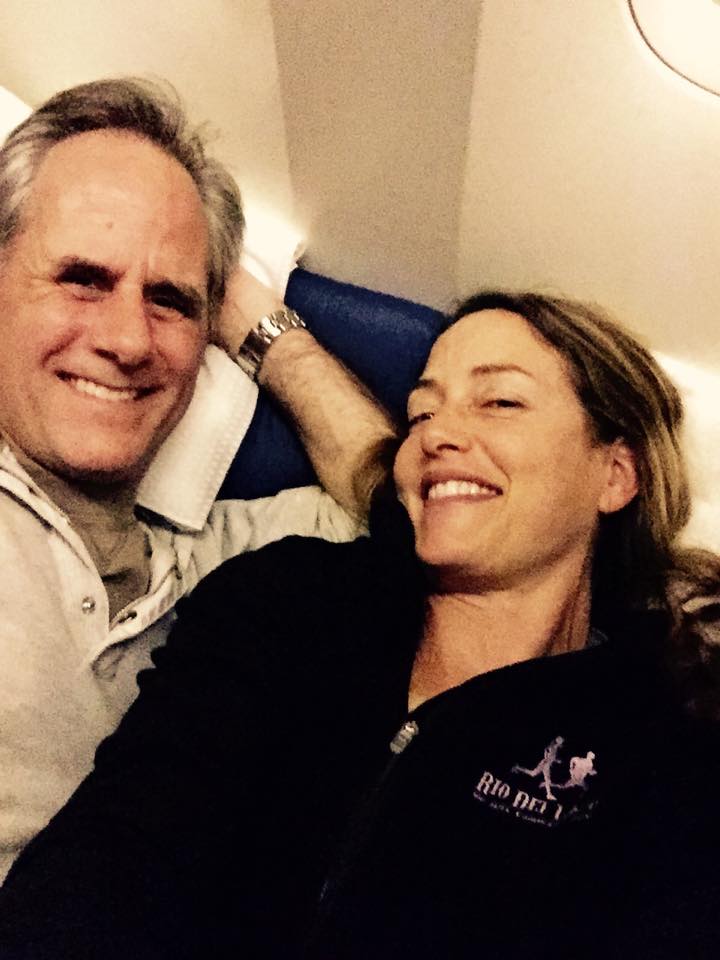
We are both only 5’7″ and yet our legs were hanging in the aisle in spite of following SkyCouch’s instructions and cuddling …
Growing punchy with the prospect of a cuddle belt and giddy with the novelty of traveling without kids, I ended up doing two things I said I wouldn’t on the flight: I drank wine and ate bad in-flight food. Then Morgan and I strapped on our cuddle belt, giggled and spooned in an effort to fit horizontally on this “SkyCouch,” and I passed out. So much for planning my 100K or joining the mile-high club.
I woke up in Auckland at 5 a.m. Wednesday feeling dehydrated, jet-lagged and fat. We had a mellow day and then went to a barbecue at Race Director Paul Charteris’s house attended by several top runners and media. I enjoyed getting to know runners whose athletic accomplishments I’ve followed online, such as Mike Wardian and Núria Picas, but I began to grow self-conscious when a couple of people mentioned I looked tired and one asked if I’d been smoking pot since my eyes were so red. To look and feel better, I drank beer.
I detoxed and acclimated the next day with a run/hike for about eight miles with Morgan on part of the Tarawera course. I felt exceptionally heavy-legged and thought, “Holy shit, I am not ready for this terrain.” But the dense, fecund forest of crown ferns and towering beech trees, which are garnished with clumpy moss, tangled vines, Frisbee-sized mushrooms and dripping moisture, enchanted me.
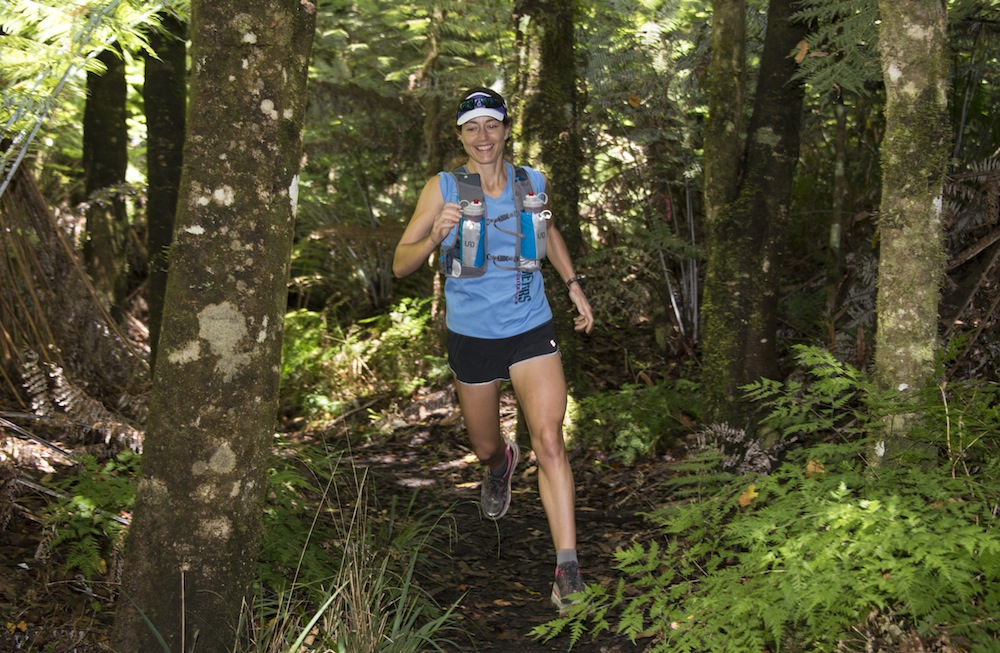
Running the Eastern Okataina lakeside trail two days before the race, wearing Ultimate Direction’s SJ Ultra Vest 2.0.
It was my first time trying Ultimate Direction’s SJ Ultra Vest 2.0, which proved invaluable later in the week when we went on long treks and I needed extra carrying capacity for layers of clothing.
Later in the day, I got in a fast, fun run of about 3.5 miles by taking part in the Tarawera Ultra’s pre-event “rogaine,” which is a cross-country run that involves navigation and teamwork [see related article I wrote about it for Trail Runner]. If you visit Rotorua, be sure to run or hike around The Redwoods Park of Whakarewarewa Forest.
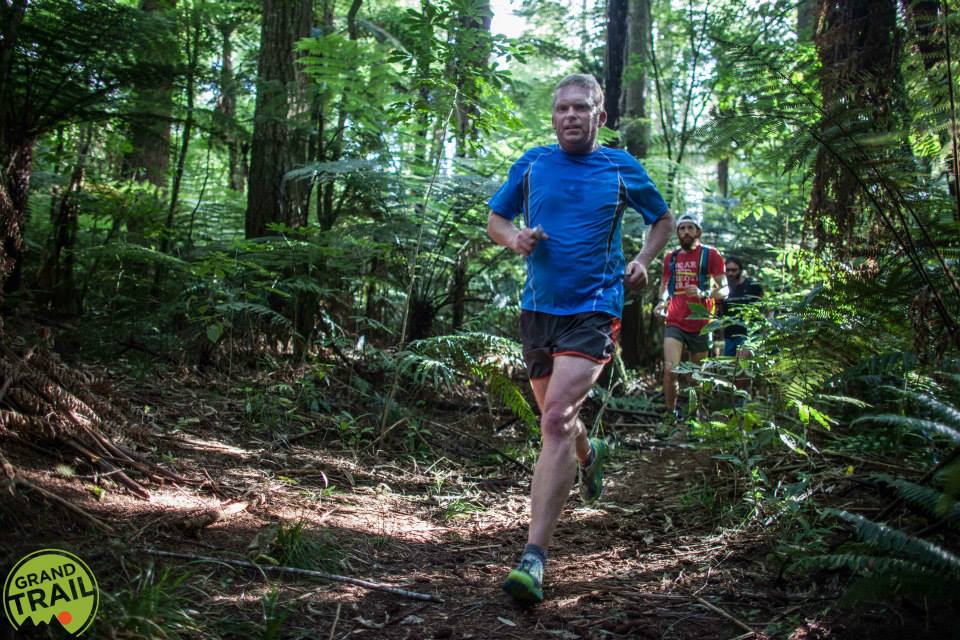
Tarawera Ultra founder Paul Charteris followed by top competitor Michael Wardian running through The Redwoods as part of the forest rogaine, a warm-up and fun event before the race.
There were so many special, fun things like the rogaine leading up to the race itself, thanks to Paul Charteris who founded the Tarawera Ultra seven years ago. It was a kick to get to know the other runners better and be a part of a team. Since I became an Ultimate Direction ambassador this year, I felt welcomed by Ultimate Direction New Zealand’s team, including Whitney Dagg and Jo Johansen pictured next to me below, with Núria Picas on the far right. (This is us before the start of the rogaine. I’m wearing the soon-to-be-released Ultimate Direction lightweight jacket called the Marathon Shell, which is awesome.)
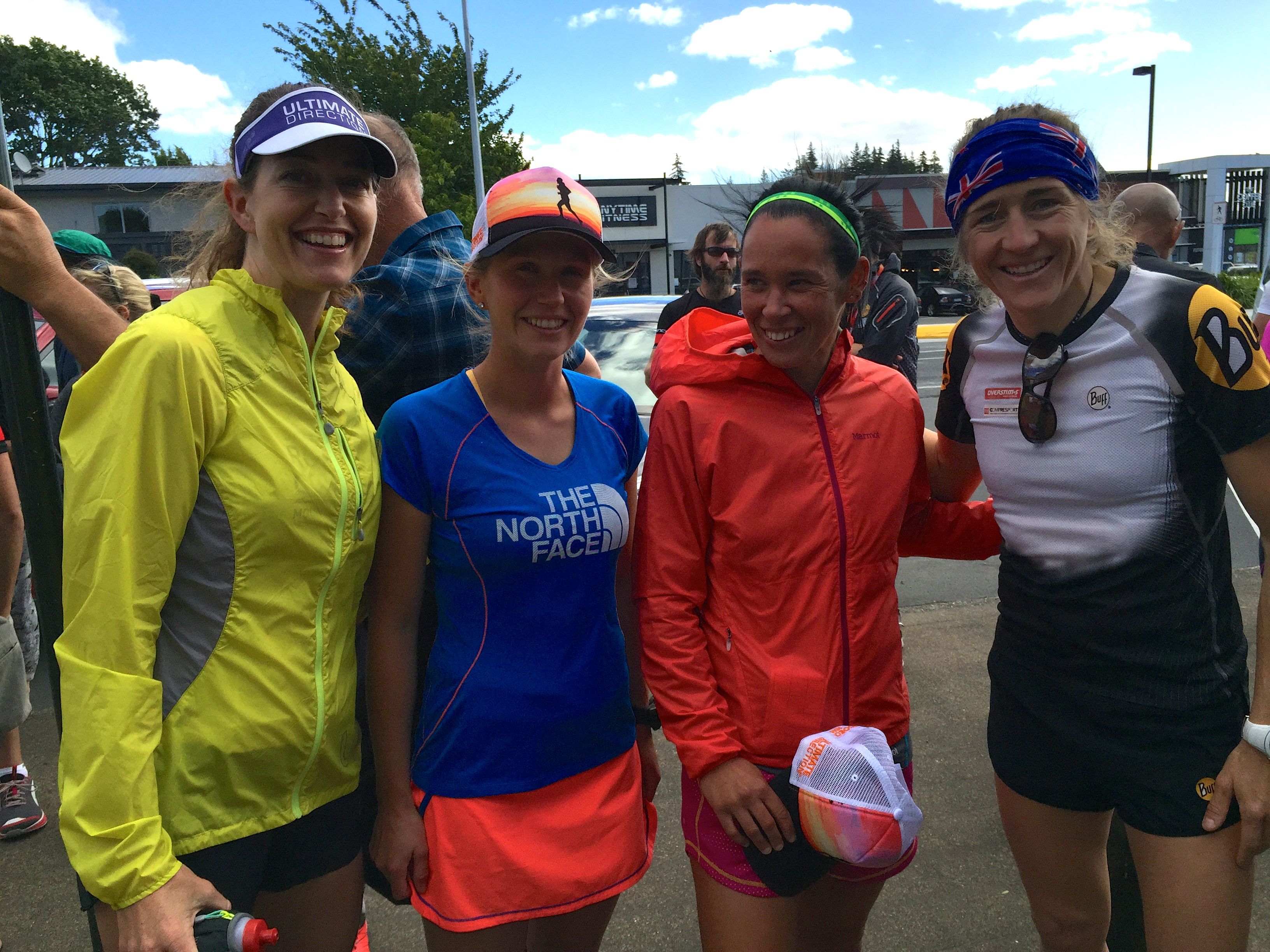
Getting to know some incredible runners: (L-R) Whitney Dagg and Jo Johansen of New Zealand, and Núria Picas of Spain.
Friday, we spent the morning at the Te Puia cultural center and Pohutu Geyser. Rotorua, ringed by Lake Rotorua and a half dozen other lakes, is centered in an active volcanic and geothermal zone, so the place smells sulfury and the ground literally vents steam in many places.
The town’s mayor, several Maori dancers and other dignitaries turned out for a welcoming ceremony. The Tarawera Ultra (which offers a 60K, 85K and relay in addition to the 100K), has grown to attract 1000+ runners and thus is a big boon to Rotorua’s tourist-based economy.
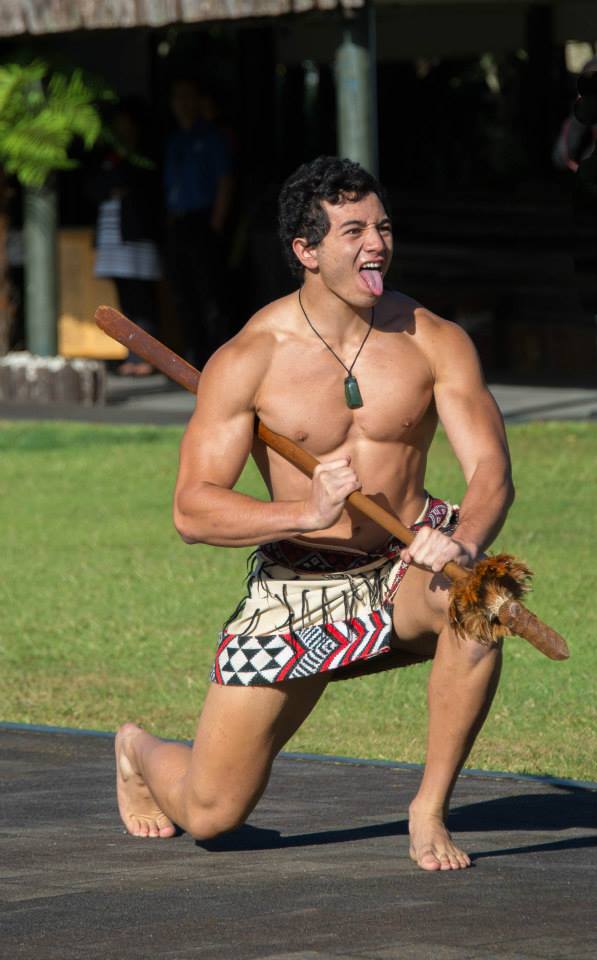
This barefoot Maori warrior, performing in front of the runners, may unwittingly have started a new trend of guys’ skirts in ultrarunning.
Paul—whom we had the pleasure of getting to know five years ago during our first visit—deservedly is regarded as a local hero. This year, he handed over the duties of race directing to his friend and fellow runner Tim Day, so that Paul could end his hiatus from ultrarunning and run the 100K himself the first time. I enjoyed getting to know both Paul and Tim better and have a lot of respect for their race directing.
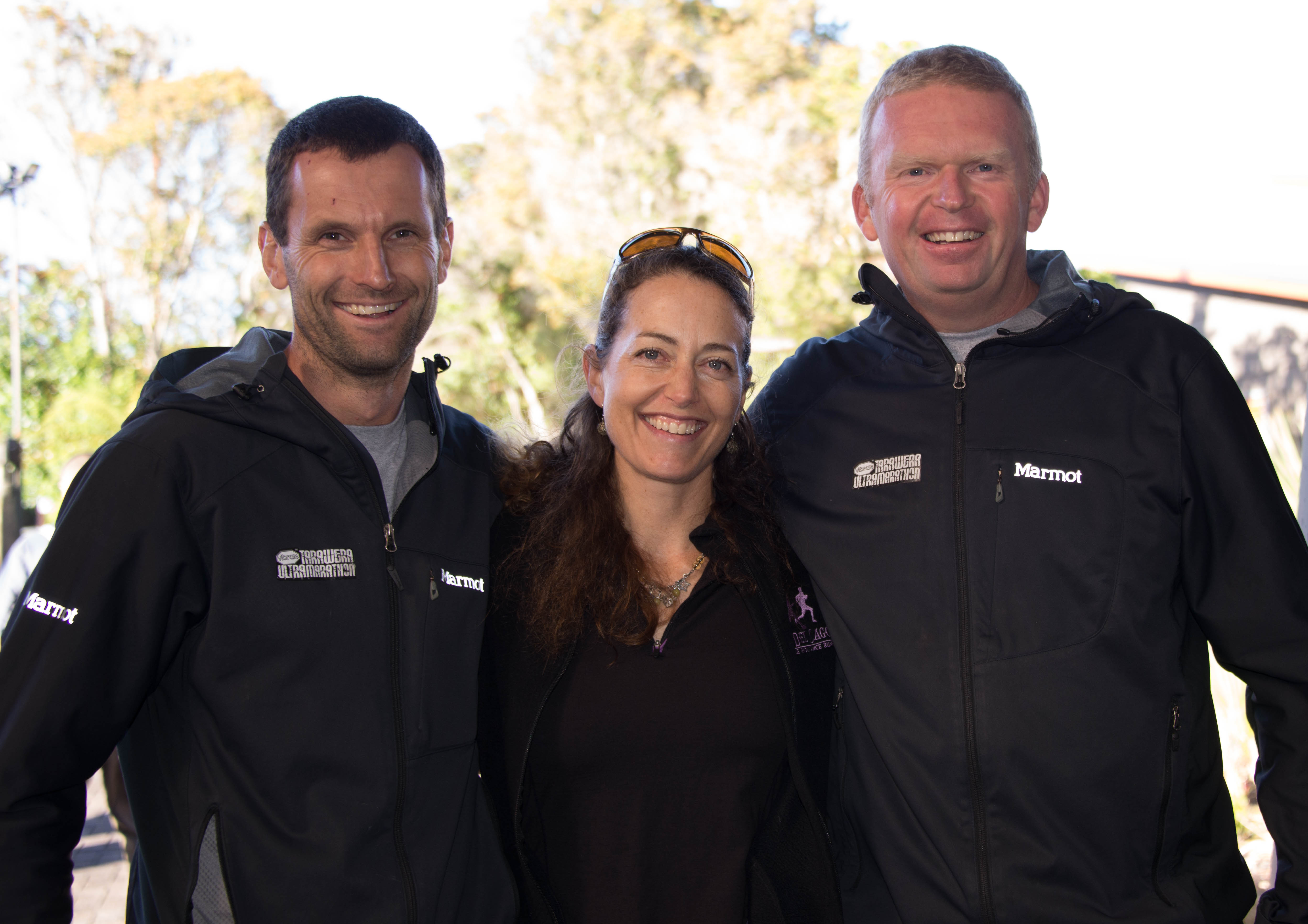
Me with Tim Day (L), this year’s RD, and Paul Charteris, who started the Tarawera Ultra seven years ago and ran it himself for the first time this year.
Sometime during that day, in between the welcoming ceremony and race expo, I laid out my gear and studied the course. With start time about 14 hours away, it was about time I planned for it.
I suddenly felt nervous as the distance and difficulty sunk in. The 62.5-mile route does not have any monster climbs, just rolling hills and a few sharp steep spikes—nothing like the relentless climbs in the Miwok 100K of the Marin Headlands (the only other 100K I’ve done, twice). But I heard the middle portion of the race, from about Mile 23 (37K, Okataina Lodge Aid Station) to Mile 37 (60K, Tarawera Falls Aid Station), are highly technical, with mossy rocks, tangled roots and low-hanging branches on narrow single track, which make it exceedingly difficult to run with a steady rhythm.
I worried the course would feel extraordinarily long, since unfamiliar routes always feel longer to me than ones I’ve run before. I also worried about my (in)ability to run well over highly technical terrain—something New Zealanders seem innately adept at.
At least I stopped worrying about the weather. It was forecast to be nearly ideal, and it was. I let go of my anxiety about possible rainstorms or heavy humidity.
The Start
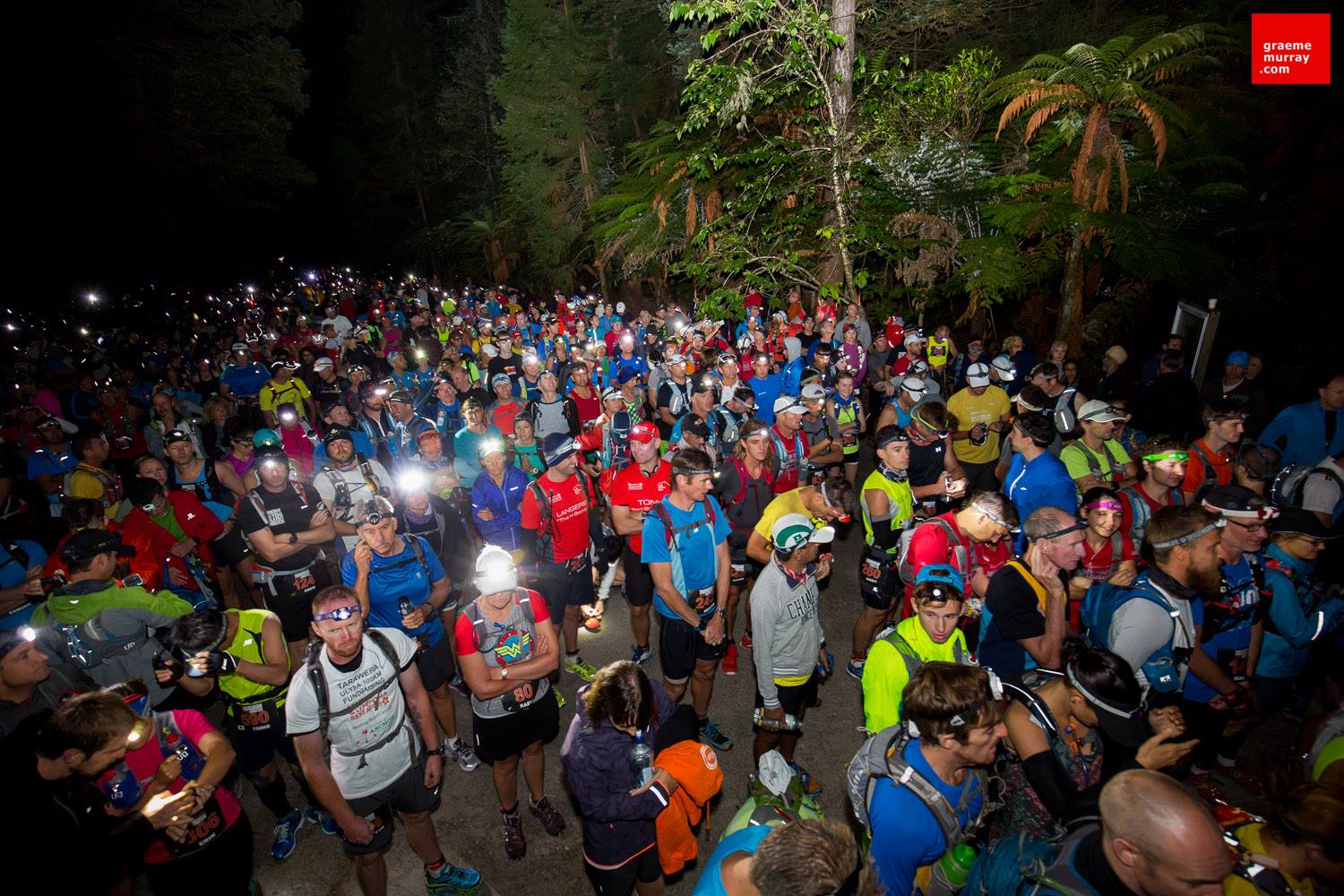
The crowd at the start. (I couldn’t find myself in this pic.) Photo by Graeme Murray courtesy Tarawera Ultra.
I slept well, woke up on time and gratefully had Morgan drive me to the start, so I could sit in our warm car until close to the 6 a.m. start time. It was cold enough to need arm warmers, and dark enough to need a headlamp or flashlight. I said goodbye to Morgan and wished him a fun day of taking photos at various aid stations. Then I worked my way up toward the start and happily found Jo Petersen, an older gentleman and phenomenal runner from the North Island of New Zealand whom I got to know during 2012’s Grand to Grand Ultra.
Jo has run every edition of the Tarawera. He said he planned to finish under 12 hours, and I told him I expected it to take me 12.5 to 13 hours. I based this on the fact that an average 12-minute mile would make for a 12:30 finish, and the two Miwok 100Ks I had done took around 13 hours each.
“Oh no,” he said, “you should be able to do it in 12 hours. The last part, on roads, is all runnable. If you can save some energy to run at the end, you’ll do well.”
Several Maoris in traditional dress performed a ceremonial dance at the start line, heightening the level of energy we all felt, and then we were off, dashing through the redwoods.
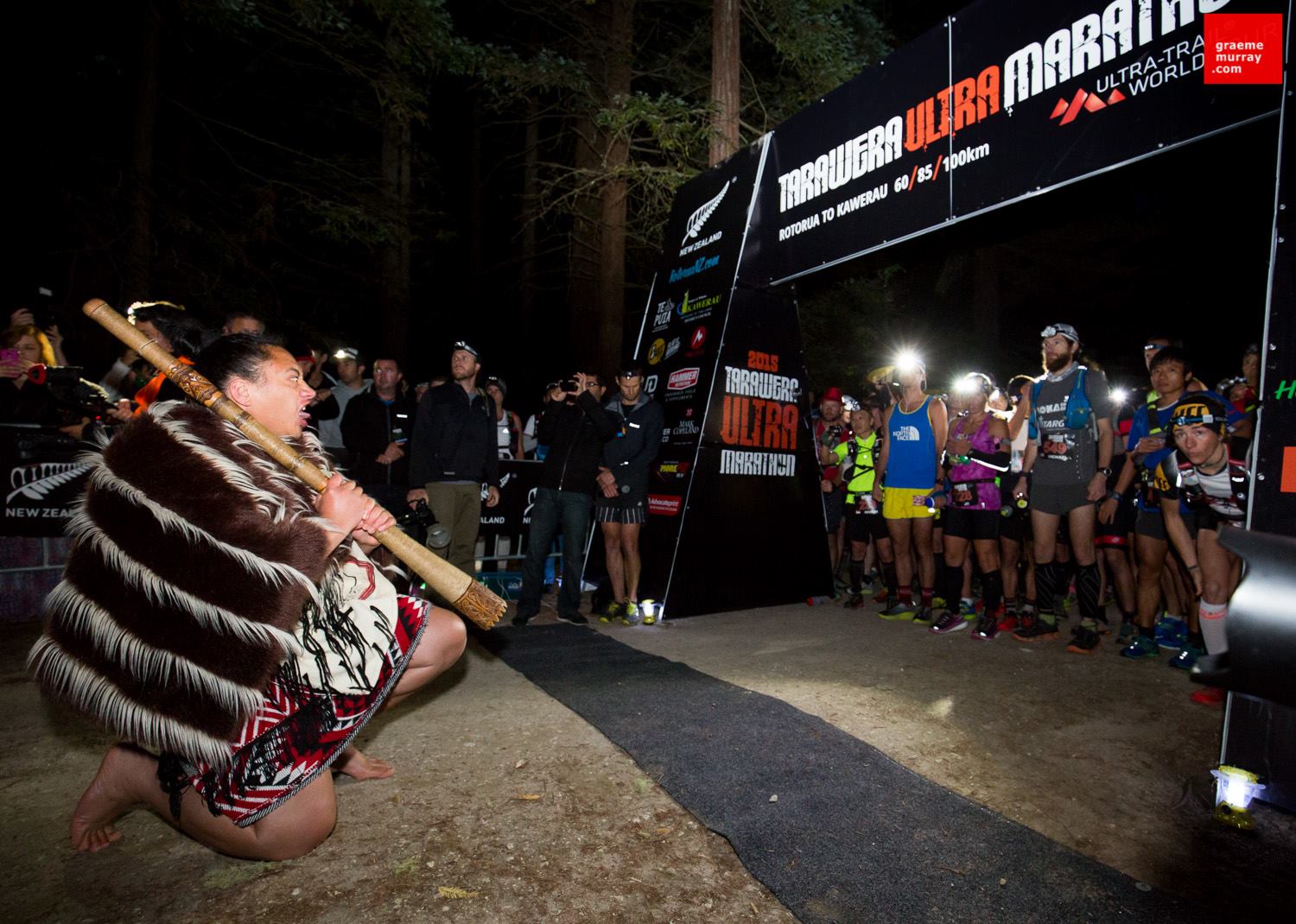
A ceremonial dance at the start line, with the elite runners looking on. Photo by Graeme Murray courtesy of Tarawera Ultra.
I told myself to stay calm and not stress out in the stampede; the best I could do was establish a rhythm and not get carried away. Inwardly, I was on the verge of freaking out.
The first 10K went by in a blur of dancing headlight beams that cast shadows in the forest. I ran strong on the downhills, keeping up with the Kiwis, which felt like luging. Then the sun came up, we hit a stretch of trail along Blue Lake approaching the first aid station, and I suddenly recognized where I was, because it was here where we camped with the kids at the Blue Lake Holiday Park five years ago. I felt a twinge of nostalgia and missed my kids. Then, reaching the shore, I got the happy surprise of seeing Morgan, who snapped lots of photos of runners, including this one of me.
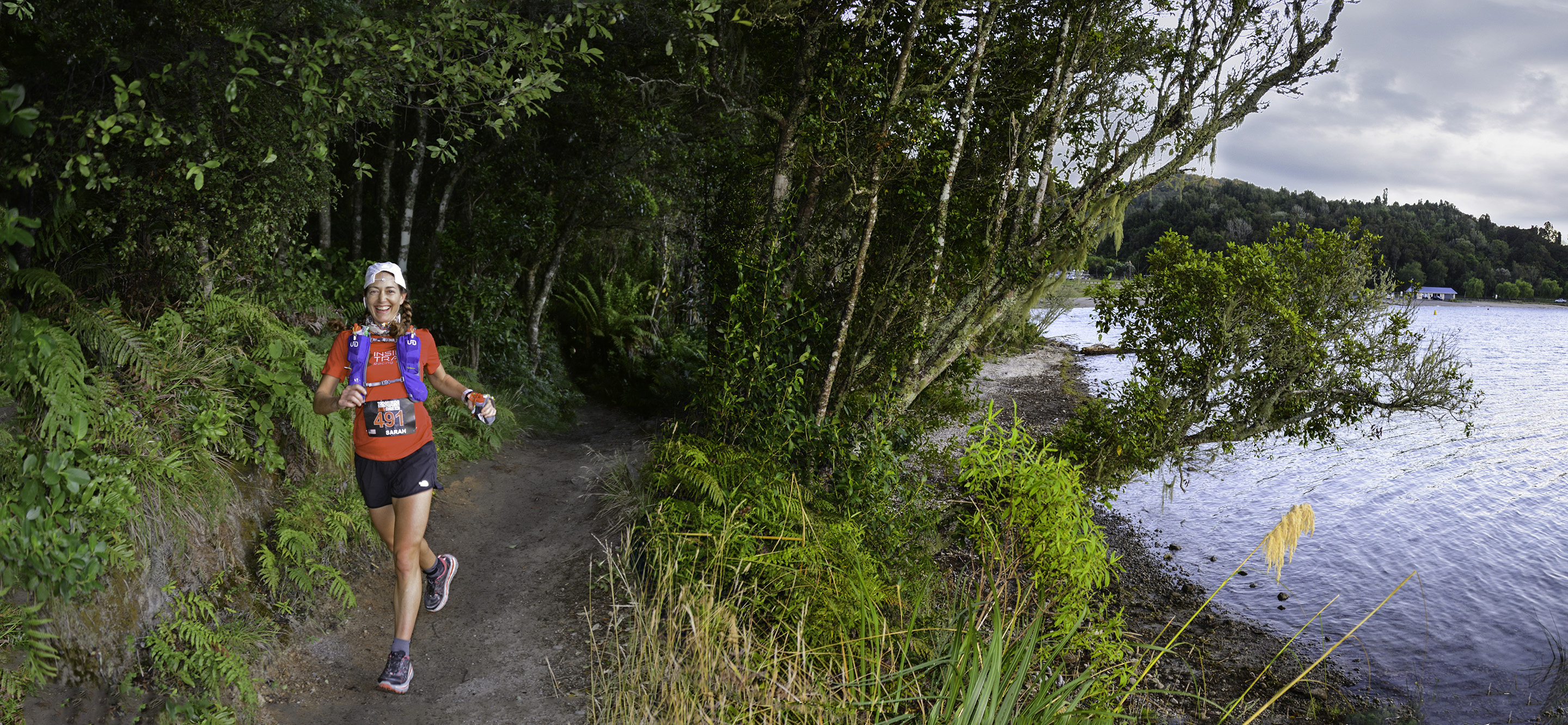
Hitting my stride by Blue Lake. The shoreline in the background is where we stayed in a holiday park and watched the kids go swimming five years ago. Photo by Morgan
I felt strong and zipped through the next aid stations, which were close together. I fueled up at Millar Road (approx. Mile 13) because we faced a 10-mile stretch without an aid station, which features a fairly significant double-humped climb of about 650 feet followed by 1300 feet. I passed a lot of people here and managed to do OK on the downhills, even though the narrow single track had eroded into a small ditch in many areas, requiring runners to straddle the ditch while stepping along the sides.
I had mentally divided the race into thirds, and when I reached the one-third point at Mile 23 (37K) Okataina Lodge Aid Station, I was happy to spot Morgan again. I also had a bite of something tasty at the aid station: fresh, grainy brown bread with jam. This would be the last time I felt like eating at an aid station.
Then I took off on the Eastern Okataina Walkway, the trail that follows the lake of the same name.
The Middle
I recognized the trail from our short run two days prior. But right after the point where Morgan and I had turned around, the trail grew increasingly challenging due to roots and rocks. I began to slow down and grow frustrated as countless runners caught up to me and wanted to pass, so I would move aside. I sensed an impatient vibe from them—even though they were all outwardly polite and said “thanks”—and it wasn’t until much later that I realized my mistake: I was stepping to the right so they could pass on the left. But in New Zealand, where they drive on the left-hand side of the road, people are accustomed to passing on the right. Therefore, I kept moving to the wrong side and frustrating the person behind me. Oh, well.
Doing my best to hopscotch over roots on my way to the Humphries Bay Aid Station (Mile 29), I slowed down and felt less and less efficient in my running. Suddenly, with a thud muted by the loamy ground made spongy with layers of rotting leaves, I face-planted and felt my right ankle twist with a sickening sensation.
I cursed, clutched my ankle, then quickly got up and moved to the side so other runners wouldn’t run into me. I could walk OK and walked for about an eighth of a mile before trying to run. It felt weak and twingy, but not terrible. The greater damage was to my psyche. I began running—or mostly hiking—even more conservatively. Both ankles felt wobbly on the roots, and I had lost all faith in my footing.
The worse was still to come. From Humphries Bay to Tarawera Outlet Aid Station (Mile 34), the trail grew even more technical. At one point I was sliding on my butt down a rocky embankment. The dark, damp forest with dappled light looked ridiculously beautiful, so sometimes I would pause to look up and around and try to regain my confidence before gingerly hiking ahead, eyes scanning the ground for tripping hazards.
In spite of my best efforts, I caught my toe and rolled my right ankle a second time. I couldn’t believe it! But the pain was momentary, so I could still put weight on it.
I got to the Tarawera Outlet Aid Station and calculated that I must have been hiking some miles at about a 20-minute per mile pace. My overall average pace was around 13 minutes per mile, so at this rate, a 13-hour finish would be a stretch. Oh boy, it was going to be a long day.
I also tried unsuccessfully to eat something. I wanted to give myself a special treat of some Nutella, even though the bread it was on looked like awful white Wonder Bread. But when I bit into what I thought would be a sweet Nutella sandwich, I instead tasted something terribly bitter. Was it Vegemite?! I spit it out and had a Gu and drank some Coke instead. The aid stations had a nice variety of food, but nothing seemed appealing.
“Just make it to Tarawera Falls,” I told myself, because that’s where the most technical parts would end, I’d be two-thirds of the way through, and I could mentally hit the reset button. I tried to concentrate on my footing and regain efficiency. However, a couple of miles from the Tarawera Falls Aid Station (around Mile 36), I became totally distracted and painfully nostalgic because I recognized part of the gorgeous river as the swimming hole where the kids, Morgan and I had hiked with Paul Charteris five years ago.
I almost wept from the surge of emotion and the beauty of the aquamarine water. I missed my two kids, worried that they felt abandoned by me, and I got lost in memories from when Colly and Kyle were young, silly kids (ages 8 and 11 when we were in New Zealand together) whereas now they’re independent, world-wise teenagers.
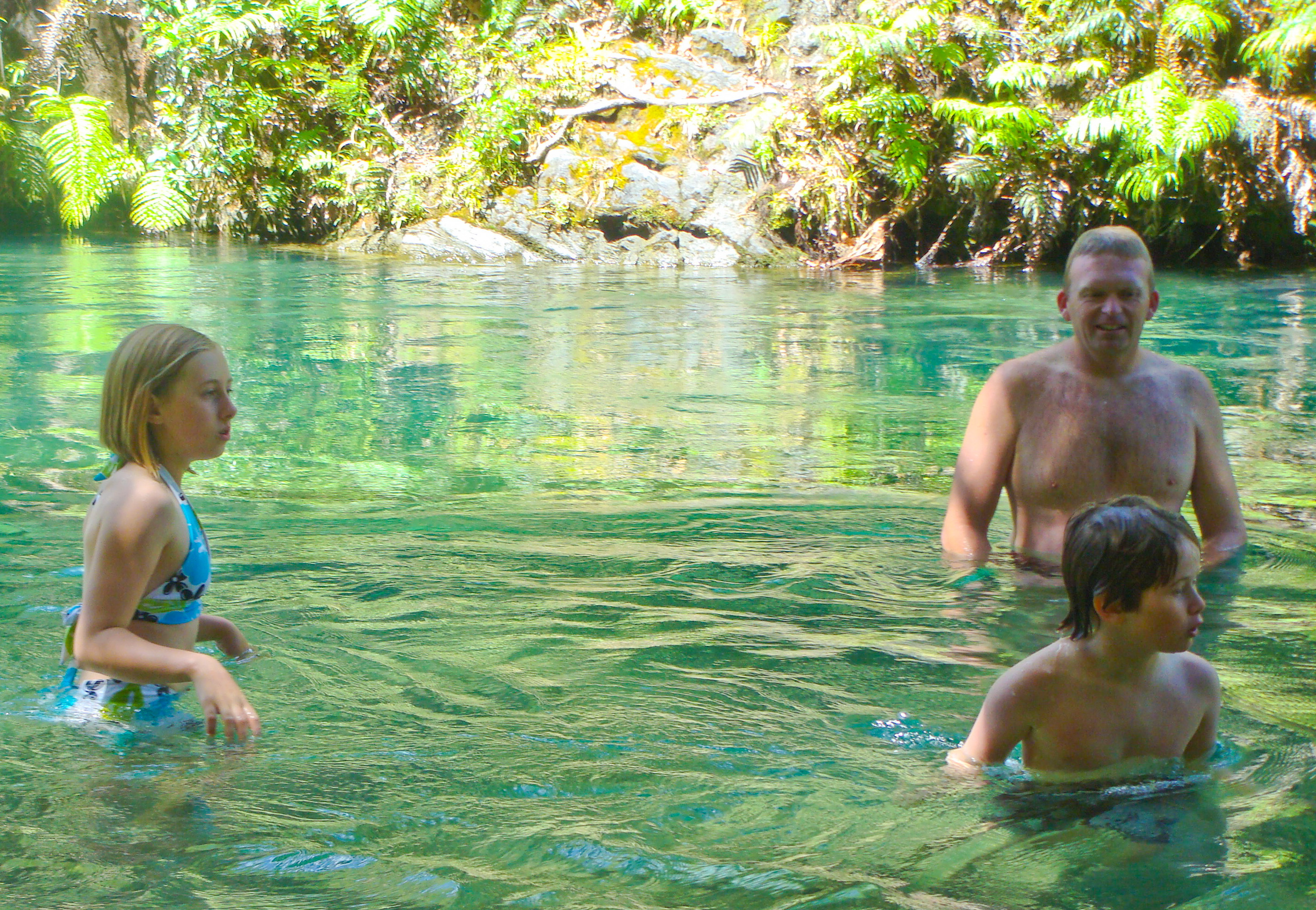
My kiddos Colly and Kyle swimming in the river next to the Tarawera race course, with Paul Charteris, in January 2010.
When I reached the gushing, double-barreled Tarawera Falls a mile away from the aid station, I paused at the overlook to admire the view and remember when we stood there as a family.
And then, for no reason other than perhaps to snap me out of my daydream and add injury to injury, I stumbled and rolled my right ankle AGAIN. God damn it!
The only emotions I felt for the next few miles were pissed off and impatient. Toughen up, ankle. F— you, tree roots. Let’s get a move on.
The Finish
Morgan surprised me again by appearing at the Tarawera Falls Aid Station. It’s a long drive there, and he hadn’t planned to go—but then he changed his mind and luckily caught me. I was in the midst of getting out my iPod (I saved listening to music for the final third of the race) and restocking my front pockets with more Gu gels and Honey Stinger chews and waffles. I acted brave and business-like so he wouldn’t know how bummed I felt. I was about eight hours into the race, with maybe five to go, so I knew I should eat some real food but didn’t feel I could stomach the aid station fare.
A tough single-track trail climbs sharply out of the aid station and then spits runners out onto a dirt road that looks like a forest service road. Then, just as Jo Petersen had promised at the start, the next 25 miles are almost entirely runnable road.
After struggling to untangle my iPod’s earbud wires, I turned up some music and felt better. Around me, runners wilted and walked the uphills. Jo’s words rang in my head, “You should be able to do it in 12 hours. … If you can save some energy to run at the end, you’ll do well.”
All day long I had been repeating a phrase, “Take what the trail gives you.” This means to make the most of whatever the trail presents, so if there’s a runnable section in the midst of hard climbs, try to run it even if you’ve been walking most of the time. Now this smooth, wide “trail” was giving me a green light to run, so I wanted to make the most of it and make up for the bad middle third of this race.
I ran steadily and did not walk the hills like so many around me. My pace on the flat sections was probably in the 8 to 8:30 range, which isn’t that fast, but it feels fast after 40 slow miles. I lost count of how many people I passed.
At Mile 43.5 (Tikoki Aid Station), the 100K runners split from the 85K runners to do a challenging lollipop-shaped loop that adds the extra 15K and climbs several hundred feet, part of it on rocky single track. The tree canopy disappears during this part of the course, so runners overheat and slow down more. But I felt OK in the heat and caught up to some of the women with whom I’d been leapfrogging early in the race, but who got far ahead of me in the middle miles.
I looked at my pace band after passing through the Mile 51 Awaroa Aid Station and realized I was back on pace to finish in my goal time of 12:30. There was only one problem: I still had more than ten miles to go, and I was hungry!
Cruising along that forest road, passing more runners and gratefully feeling no pain in my weak ankle, I felt lightheadedness and other warning signs of an oncoming bonk. I ate more Gu but had a growling stomach. I was running quite well, relatively speaking—but how long could it last?
I must have switched into survival mode, attuned to whatever could help me endure, because something came into my field of vision that my reptilian brain instinctively tuned into and seized upon before my frontal lobe registered what was happening. This thing was lying in some bushes by the side of the road, about 14 inches long, more brown and black than yellow.
Like manna from heaven, this thing that turned out to be a giant rotting banana presented itself as a gift, just when I needed it most.
I didn’t hesitate to pick it up, peel it and inhale it while running along. It was easy to get down, all warm from the sun and mushy like baby food. I knew as I ate it that it had the calories and potassium my body craved. It was the best thing ever!
As the final hour and final 10K loomed, I listened to a string of upbeat songs on my iPod and decided to up the ante to a 12-hour finish. Strange and laughable visions flashed through my head, including the ugly nun in Sound of Music who sings Climb Every Mountain. I was going bananas, after all. I was in the late-race zone where fatigue blends with fervor, and stopping to quit or speeding up to make it to the finish on time feel like the only two extreme options available.
I reached the last aid station with 5K to go and about 28 minutes left before hitting 12 hours. I can run a 9-minute pace for 3.1 miles to make it on time, I told myself. But the final stretch went off road and returned to windy single track, so I got nervous—but that helped me run faster.
About 200 meters from the finish, I suddenly saw Morgan off to the side. He spotted me and heightened the drama by yelling, “Oh my god!”
He told me later, “I had my book and some food, and I was going to sit under a tree and read. I thought you were going to take another hour.”
I finished with two minutes to spare, a few seconds under 11:58 and the 20th female.
And that’s all there is to my Tara-we’re-a-long-way-from-California report. Except for a couple of random pieces of advice below. Big congrats to the two Bay Area guys who finished first and second, Dylan Bowman and Jorge Maravilla!
Tips for Tarawera and other long ultras:
Gear recommendations: I’m glad I decided at the last minute not to use drop bags. I prefer to carry what I need in my pack, rather than spend time hunting for a drop bag at an aid station. I had a good amount of space for extra gels in the back of my Jenny Ultra Vesta.
Also, studying the distance between aid stations, I noticed there were a couple of long stretches—one with 10 miles in between, another with 6—where I might need more than the 20 ounces of liquid that the Jenny Vesta carries, but I didn’t want to add a hydration bladder to the back. I like being able to see the amount of liquid I have, and easily refill it, hence I prefer bottles on shoulder straps to a bladder in back. So I added the Ultimate Direction Handy 10 to my gear—a small handheld bottle with a pocket that’s the perfect place for a baggie of electrolyte pills. I ended up being quite happy with this combo of a vest and small handheld, as it was the ideal amount of liquid, pockets and weight.
A couple of notable things I decided NOT to use, and was glad I made that choice. I did not use my Garmin because it would run out of batteries before the finish, and I wanted to run more by feel than by following the Garmin’s pace reading (which would probably be inaccurate in the windy forest trails anyway). I wore a simple Timex stopwatch instead. I also decided not to take sunglasses. A hat was sufficient for sun protection, and given the forest canopy and dappled light, I needed to run without glasses to see the ground well.
Make a pace band. When you’re running an unfamiliar ultra course, it’s really helpful to have a handy reminder of the aid station locations and a rough idea of when you might reach them—a best-case target goal pace, and a slower target pace that is the lower end of your goal, so that you have a target pace range to aim for while running.
It’s easy to make a pace band: just create a table in Word, with four rows and however many aid stations exist as the number of columns, plus one. Label the rows in the left hand column “AS,” “Mileage,” “XX:XX pace” (fill in XX:XX with your best-case minute/mile pace), and “XX:XX pace” (fill out these X’s with your slower goal pace). Then, in the top row, label the rest of the columns with abbreviations of the aid station names. Fill in the next row with each aid station’s mileage location. Then fill in the next two rows with the time it would take to reach each aid station based on best-case pace and the slower pace.
Choose “landscape” in printer settings so the whole band fits on paper when printed; cut it out, use a strip of packing tape to tape one side of it, and fold the packing tape over the back so you’ve effectively laminated it. Take it to the race, along with extra tape and scissors to cut it to size, and tape it around your wrist the night before. (It’s a bit tricky, but do-able, to make a 100K pace band that fits without being too long to fit well around your wrist. You just have to make the print small and columns narrow. For 100-mile ultras, make two: one for the first 50M, another for the second 50M.)
This has been such a worthwhile trip. Soon to come: a blog post on some South Island trekking we did following Tarawera.

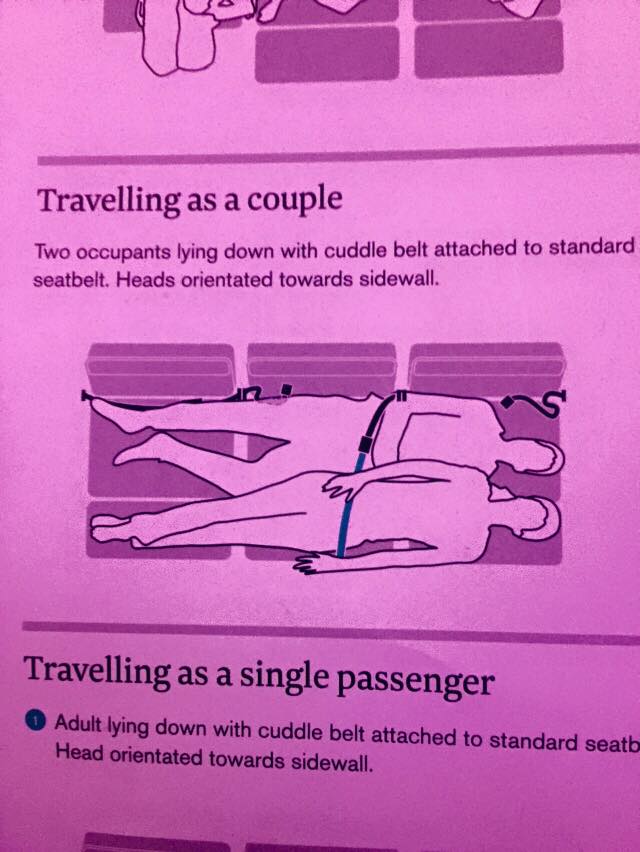
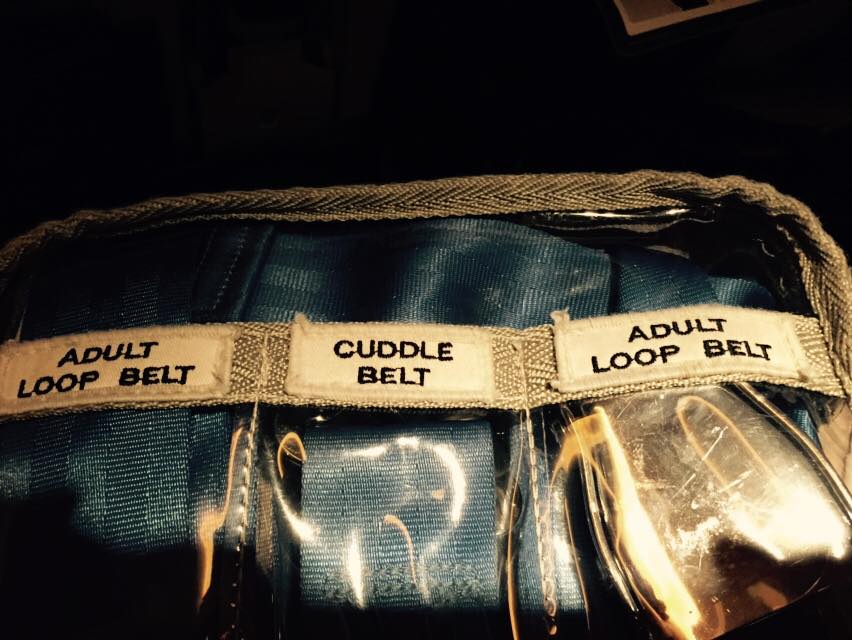
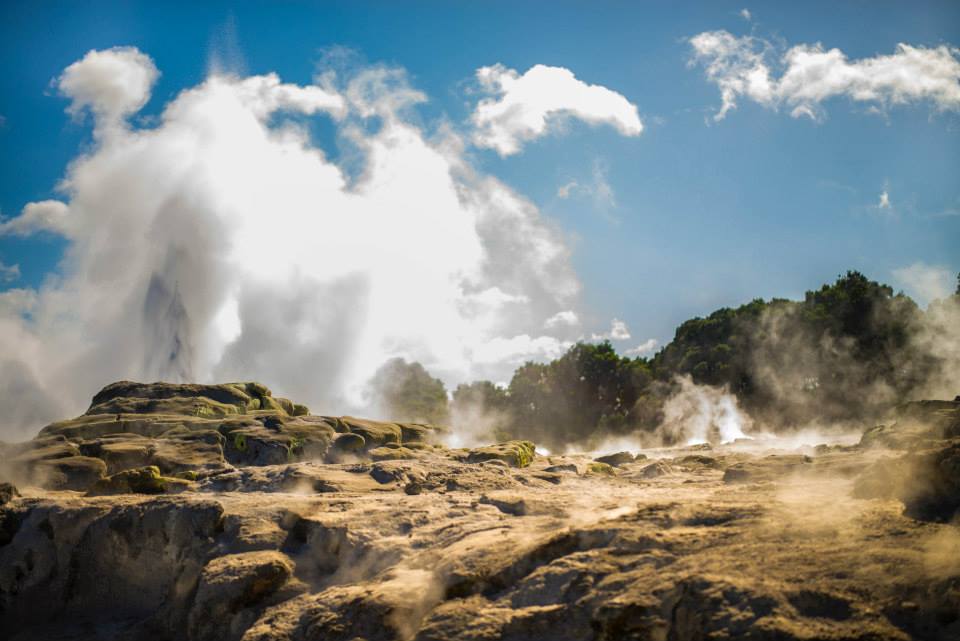
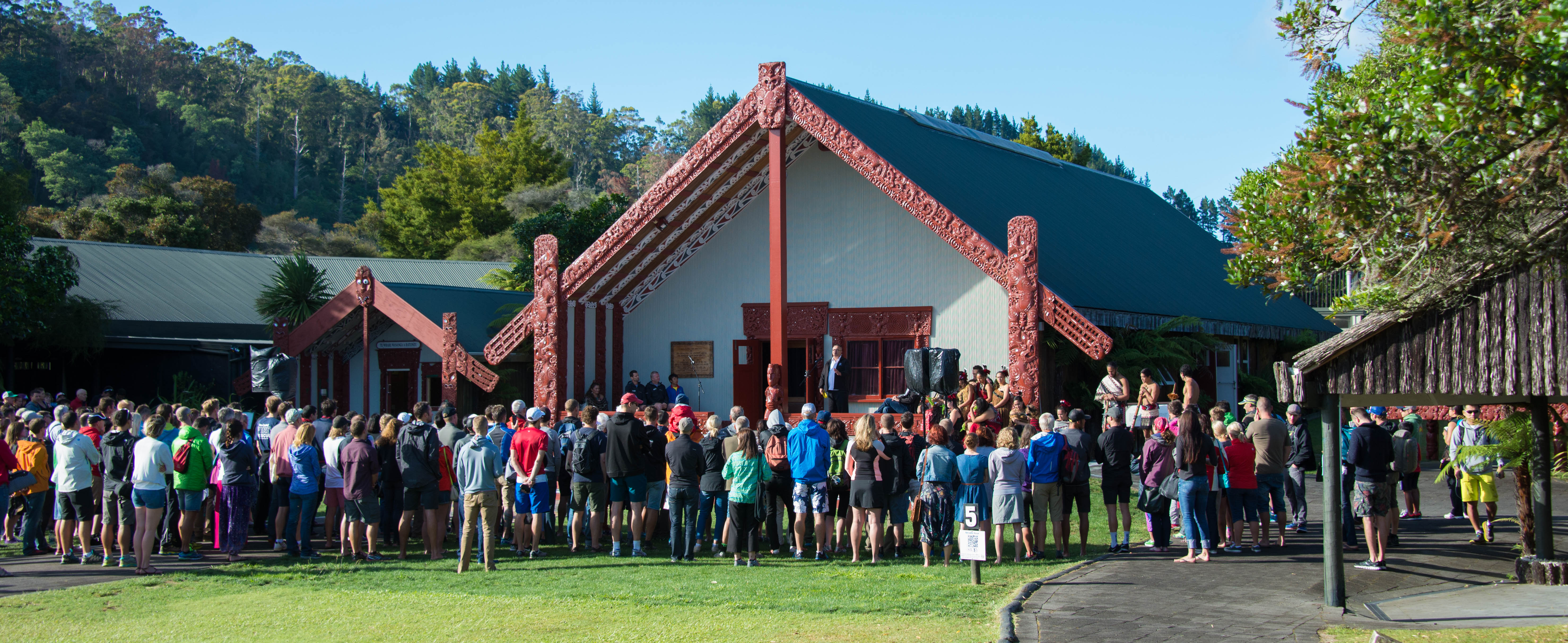
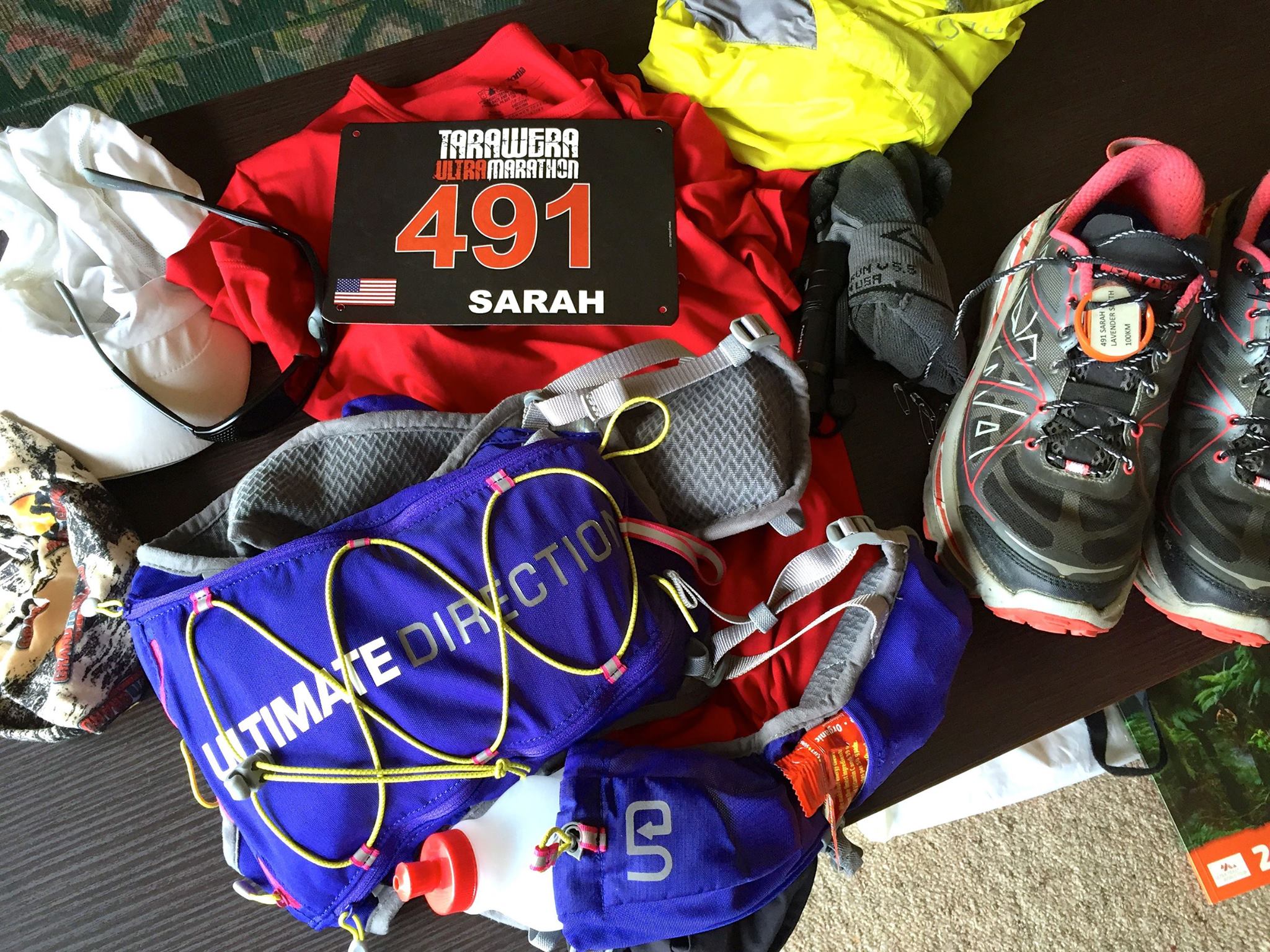
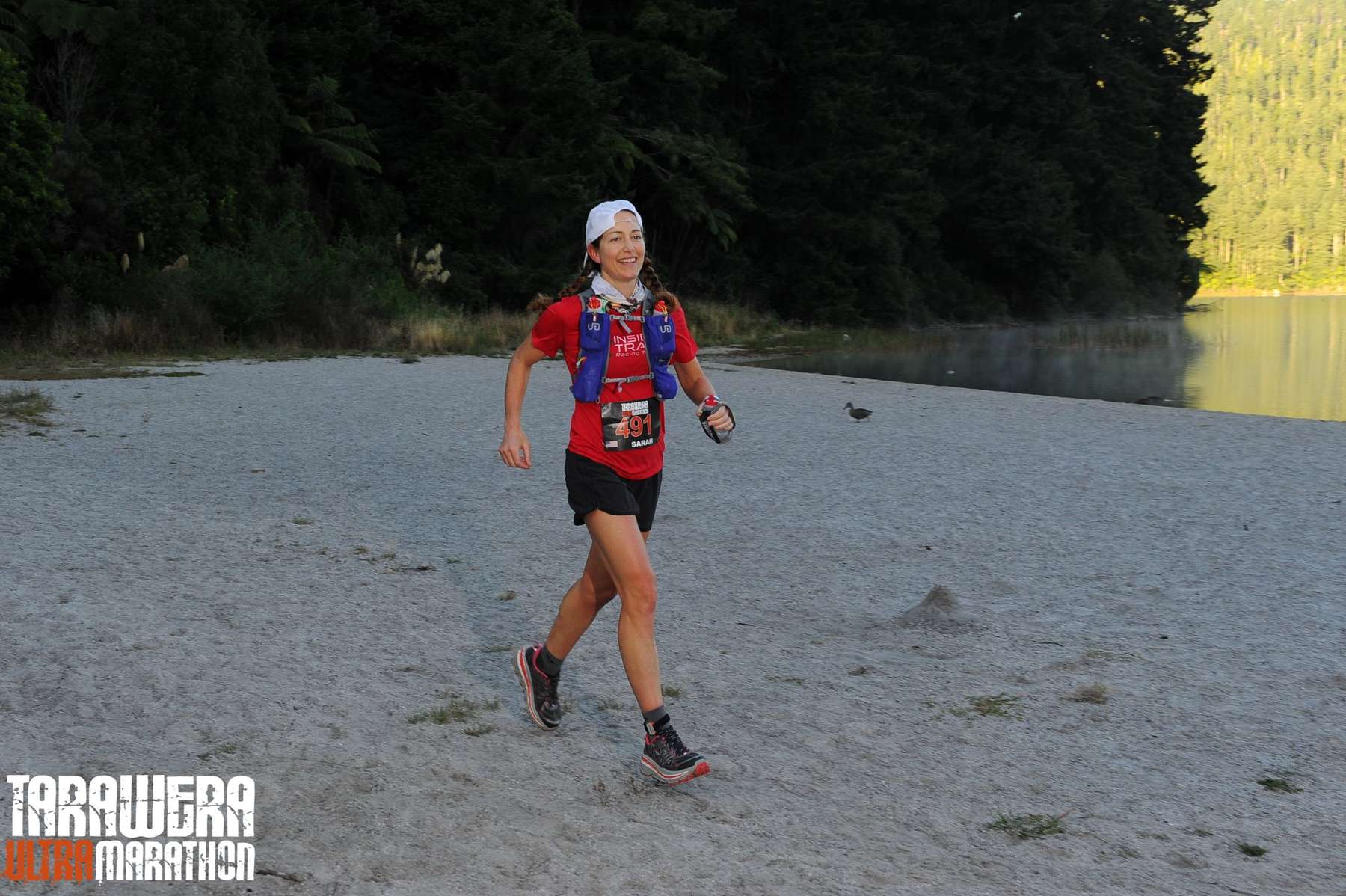
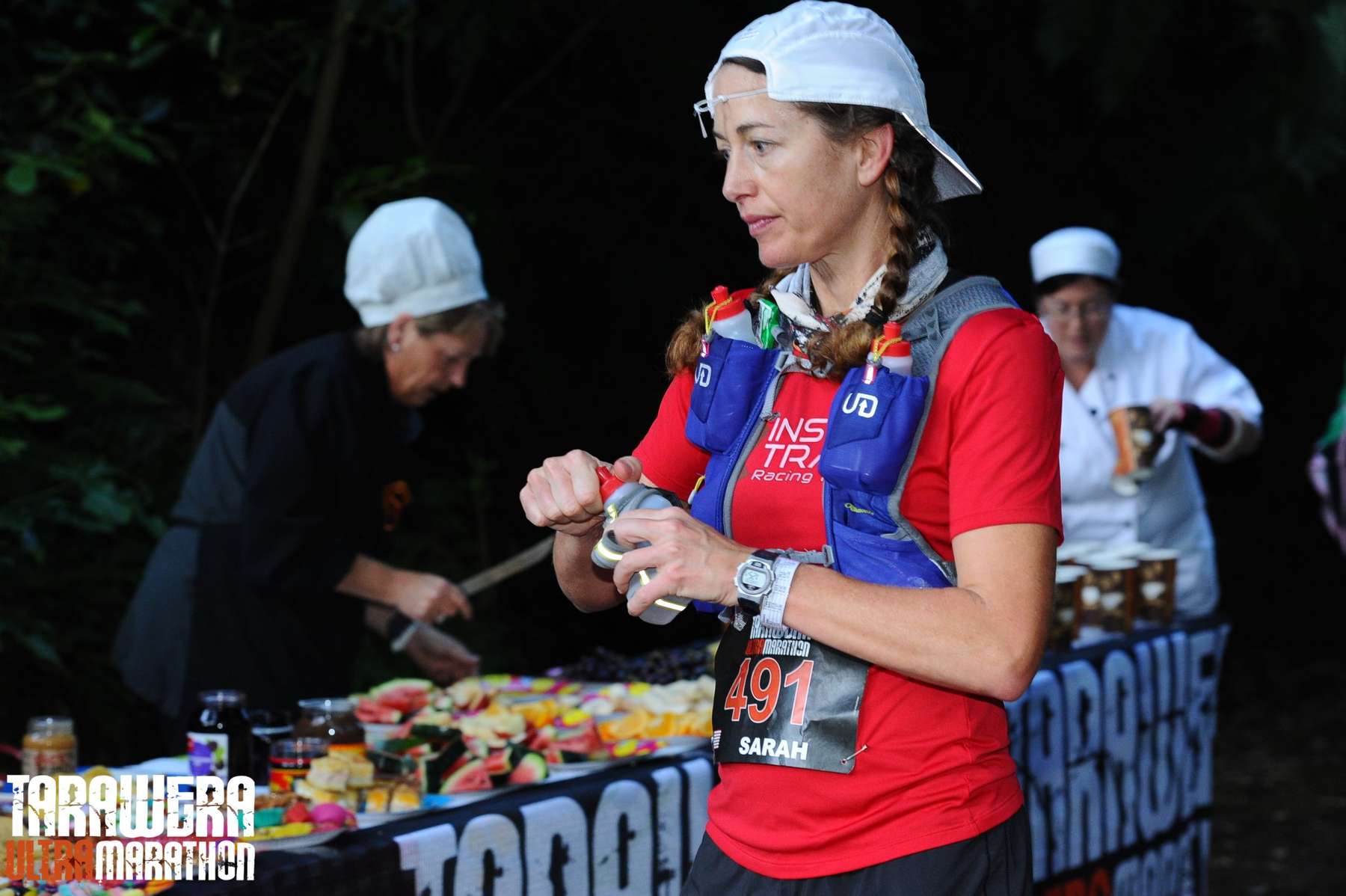
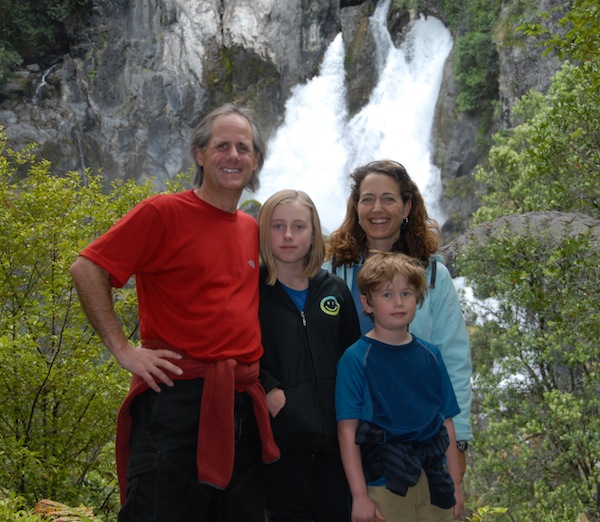
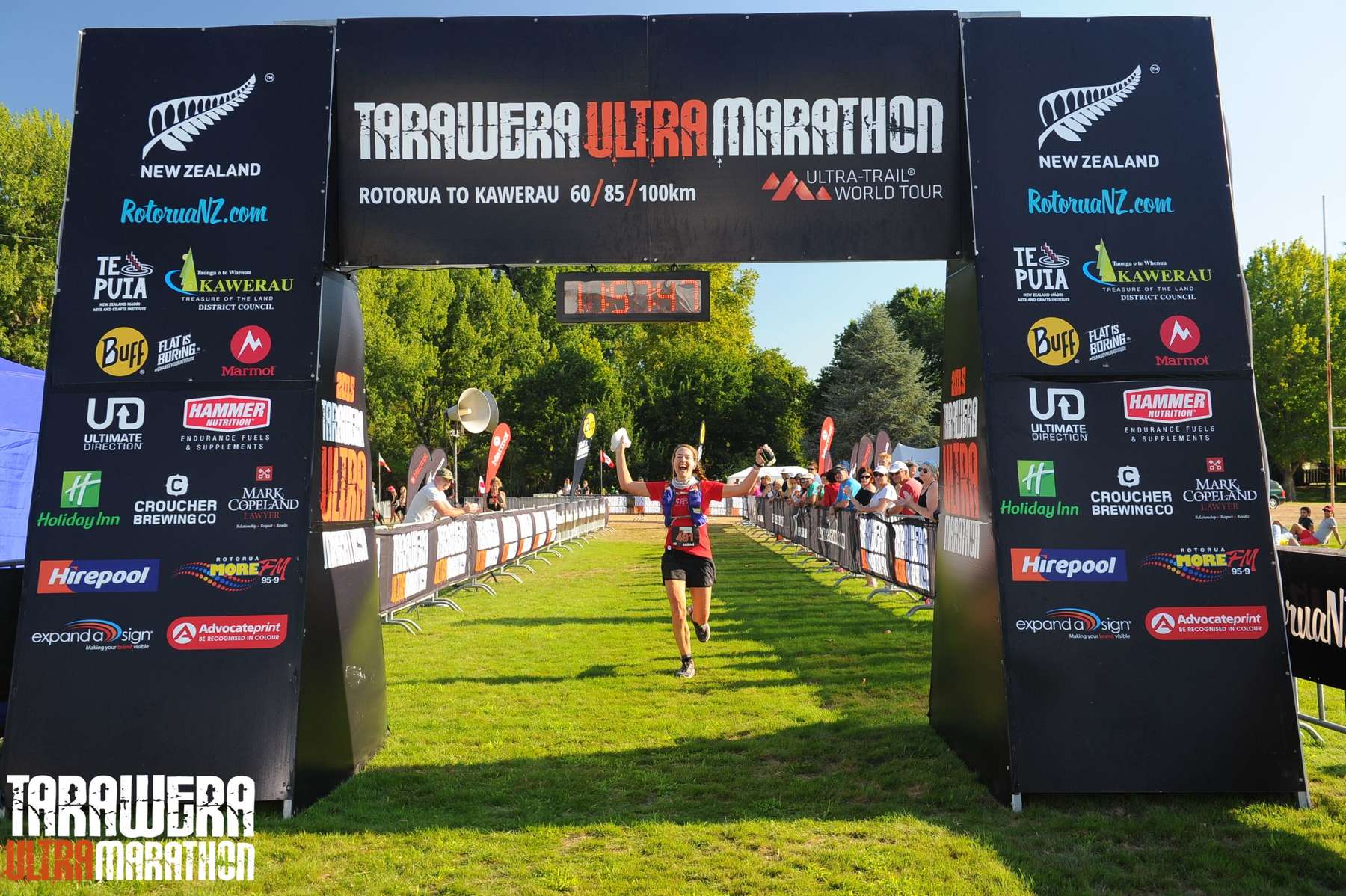
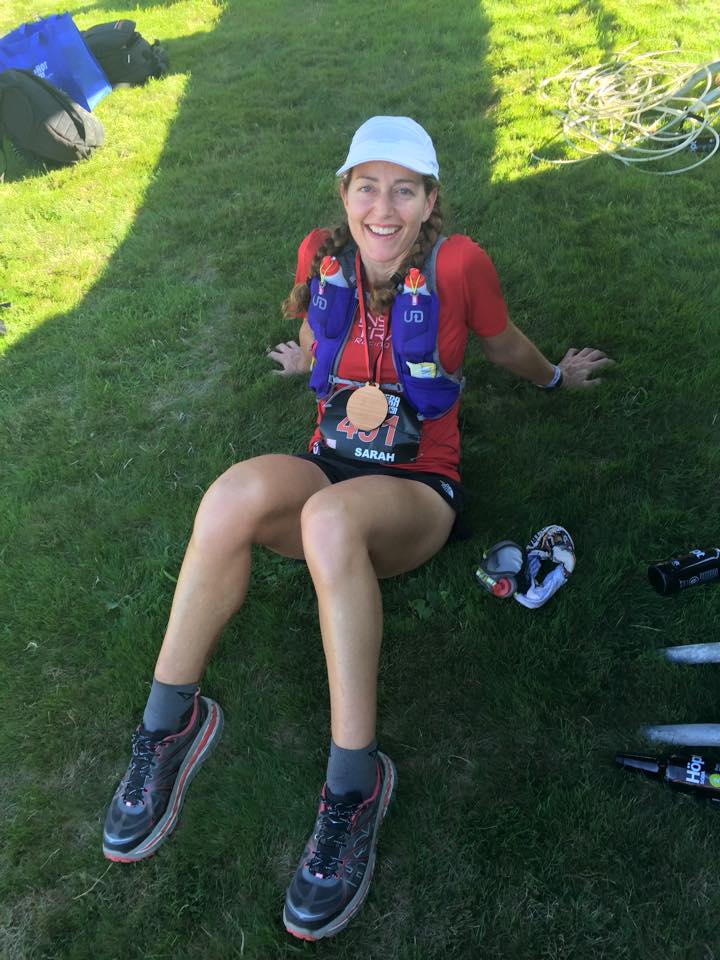
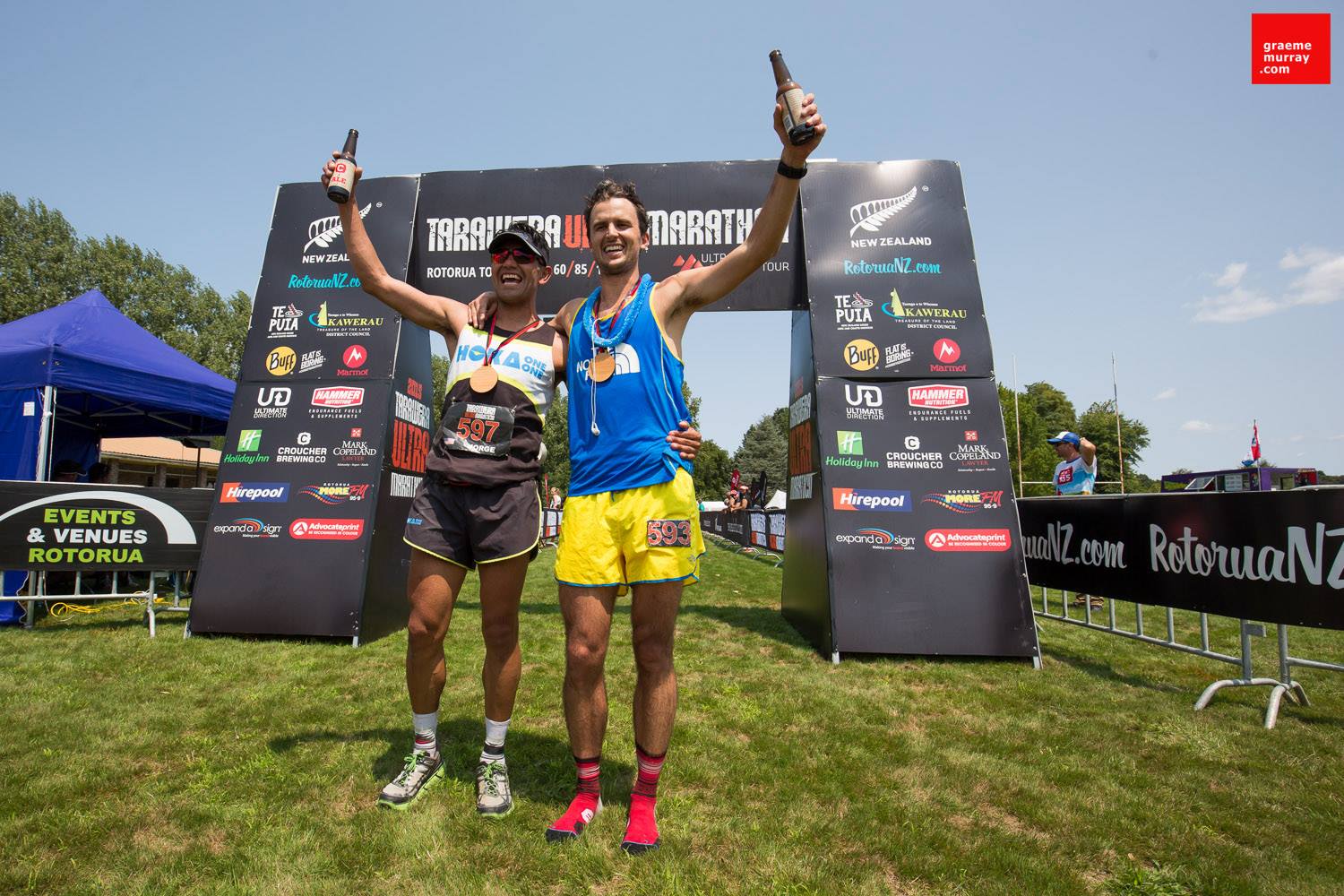

I had to laugh about the passing on the left thing – when we did trail races down there I had the same issue, especially with people (or bike riders) coming towards me. I got the knack for the driving pretty quick, but on foot I was still messed up. I love how you rose to the challenge, and how a very ripe banana was your salvation. Congrats on a great race!
WOW! Looks like an amazing race! Beautiful photos! You look so happy.
What type of shorts are those? THey look confortable!
Your smile is fantastic in that last picture! I only hope to look so good at the end of a long event.
Thanks! They’re the North Face “Better Than Naked” shorts.
Sarah,
What a great report! Thanks for taking the time to write it and how neat to visit and race in an area that you were in before. I can imagine how moving it must have been to see those places again especially with your kids growing up. You are a wonderful writer!
Glad I found this race report. I just signed up for the Tarawera 100K (my first). I’m also from the Bay Area (East Bay) and am running North Face 50M this December. Thanks for sharing your story. Lots of great info!